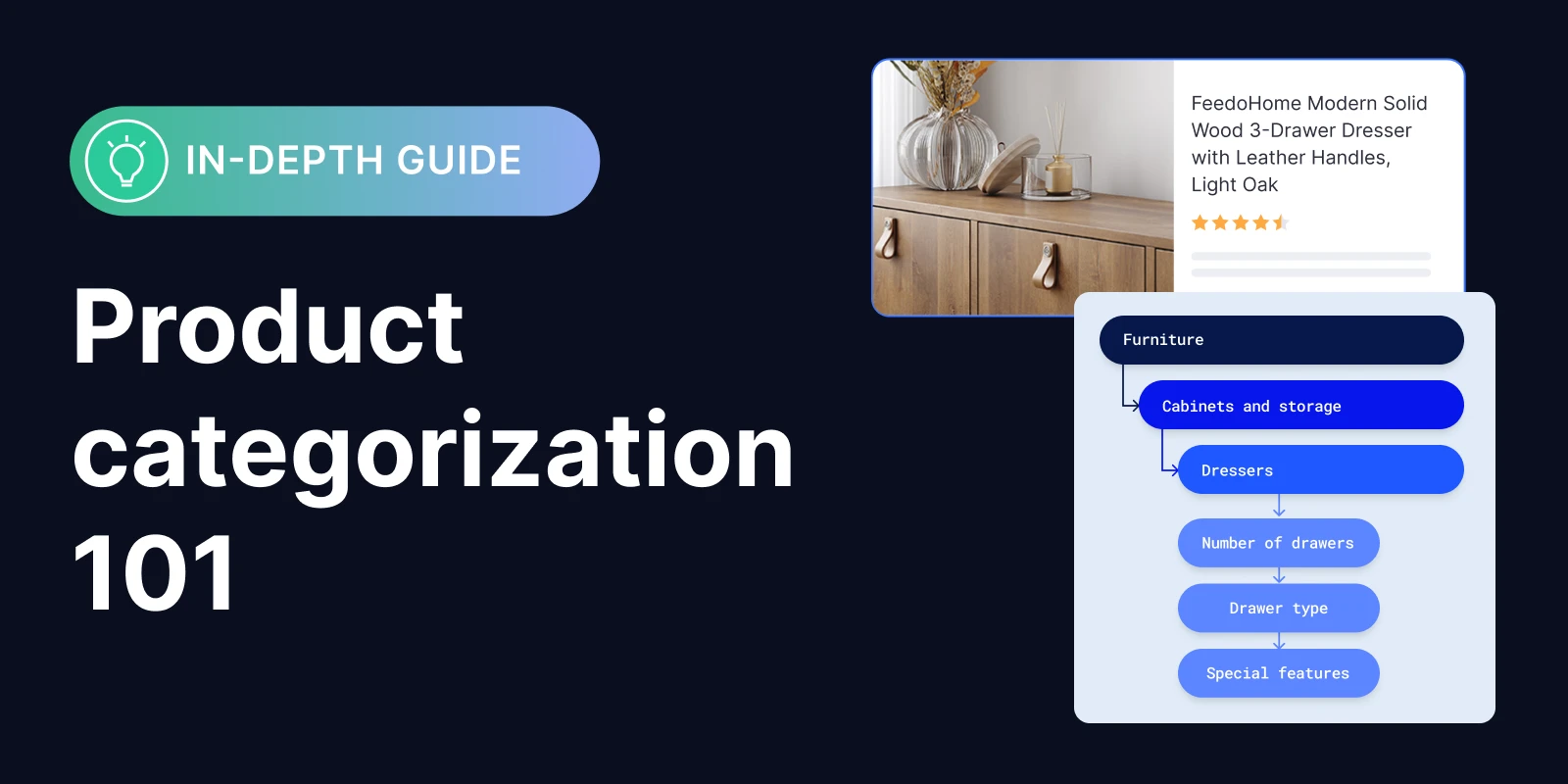When today’s shoppers look for a product, they rely on search engines, marketplaces, social commerce platforms, and AI-powered recommendations. 8 in 10 online purchase paths include interactions across multiple channels or sites, according to Google’s analysis of U.S. consumers.
Browsing category pages on Amazon, getting personalized product suggestions on TikTok, and interacting with ads across Google, Meta, and other ecommerce channels are all part of the modern shopping experience.
Regardless of the path from discovery to purchase, one thing remains constant: shopping platforms need to understand what your product is in order to show it to the right customer.
That’s why product categorization is so important.
By placing your products in the correct categories, you’re telling each platform exactly what you’re selling, so it can match your listings to the right shoppers. Accurate categorization affects everything from how your listings are displayed to how they’re grouped in campaigns—and even whether they get shown at all. For omnichannel sellers, this can be the difference between growing revenue and getting buried in irrelevant results.
In this blog we’ll show you what product categorization is, how it works, and how to implement it at scale for your product catalog.
What is product categorization?
In a nutshell, product categorization is how a marketplace or ad platform groups your products into distinct, hierarchical categories. Similar to classification within the animal kingdom, channels have broad categories (or taxonomies) that branch into more and more specific groups.
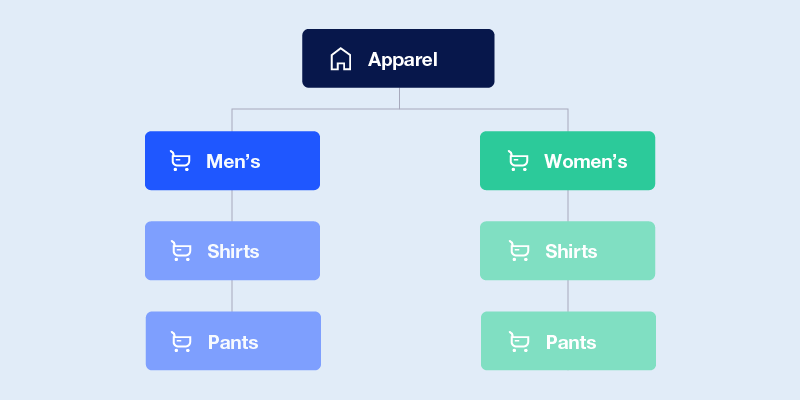
Why is product categorization so important?
Proper categorization plays an important role in product discoverability, how your product listings are displayed, and even how sales tax is calculated. Advertising campaigns and operational procedures are also improved by accurate product categorization.
AI-powered discovery engines also rely on high-quality structured data to help generate the best results for users.
Accurate product categorization improves the customer experience
Accurate product categorization improves the customer experience and also helps merchants reach the right shoppers.
For example, if a customer searches for a wooden coffee table on Amazon, and your wooden coffee mug shows up in their search results because it’s miscategorized, you are not reaching the customers who want to buy your mug. If you are selling a wooden coffee table that is not correctly categorized with the other coffee tables, again, you’re missing the opportunity to reach somebody who is browsing through coffee tables.
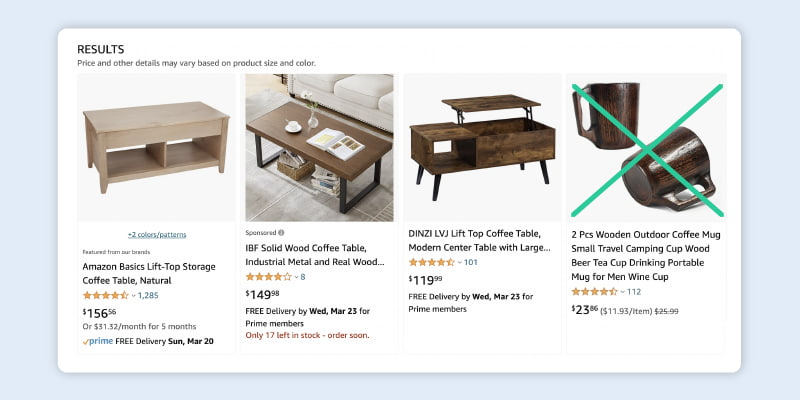
Granular product categorization unlocks category-specific attributes
In addition to supporting search visibility, product categorization helps marketplaces and ad platforms determine which product attributes should appear in your listings. These attributes are often tailored to specific categories and subcategories, and they can significantly enhance the quality and clarity of your listings.
For example, a high-end home decor seller doesn’t want its dressers to be categorized simply as “Furniture,” or even the slightly more specific “Cabinets and storage.” The best categorization drills down to the most granular level—“Dressers.” This unlocks structured fields for showcasing relevant product details such as the number of drawers, drawer type (e.g., ball bearing slide), and special features like a felt-lined interior.
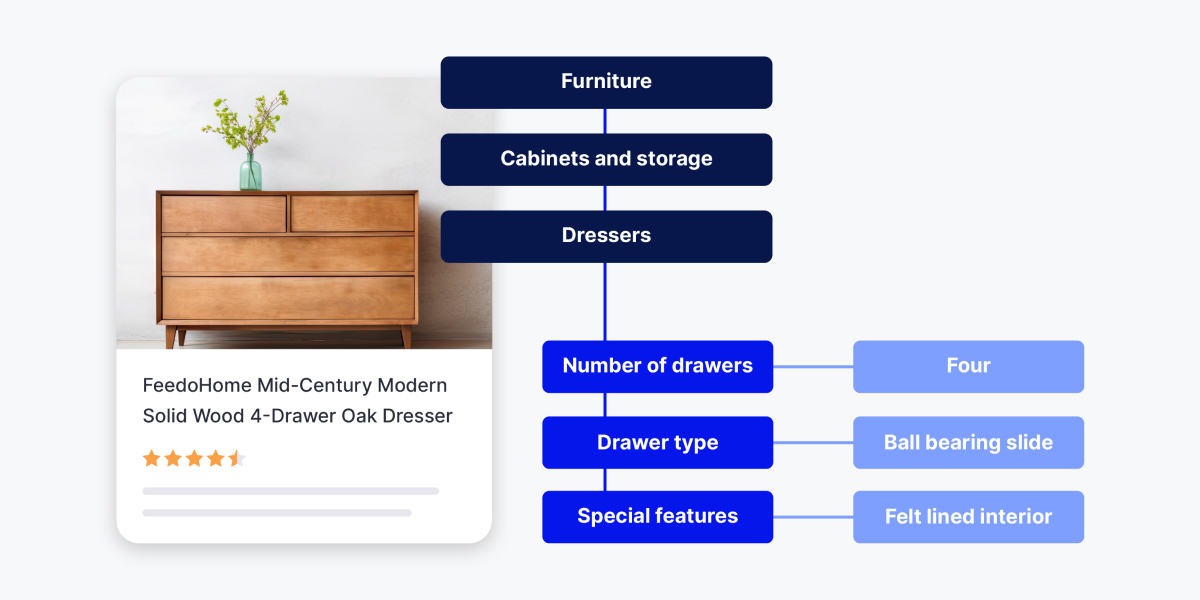
These fields help shoppers compare products more easily, increase the likelihood that your listing will appear in filtered search results and “related product” sections on marketplaces. When those attributes are missing—or hidden because a product is placed in a broader, less accurate category—your listing becomes less competitive.
Let’s say a customer is browsing for furniture on a channel like Google Shopping or Amazon. If your product is categorized correctly, that platform will know to display it alongside similar items and apply common filters like “number of drawers” or “dimensions.” However, if your dresser is incorrectly categorized under a generic furniture category, you lose access to those structured fields, and your listing might get passed over, even if the product is exactly what the shopper is looking for.
Proper product categorization aids in advertising campaigns
Marketplaces and ad platforms also use product categorization to group products in ad campaigns and remarketing efforts. Amazon and Google promote products and provide recommendations to customers based on their activity, search history, and previous purchases. Accurate product categorization increases the likelihood of your product getting recommended to potential customers who have shown interest in a particular product category.
Let’s say that an Amazon customer has an affinity for purchasing wooden drinkware. Amazon uses this information to recommend or promote similar products within this particular category to the customer. If your listing for a “wooden coffee mug” is improperly categorized, Amazon has a difficult time connecting your product to this ideal customer.
How do you ensure accurate product categorization at scale? Learn how Feedonomics can help.
Good product categorization improves inventory and bidding strategies
Proper product categorization also benefits merchants on an operational level. Creating your own product groups can streamline inventory distribution across marketplaces and improve bid strategies on ad channels.
For instance, if your online shop sells equipment and apparel for various winter and summer sports, you can create broad categories internally based on the season. By doing so, you can organize your product ads to increase bidding on ad placement for snowboards during the months when more customers are actively searching for winter sports equipment.
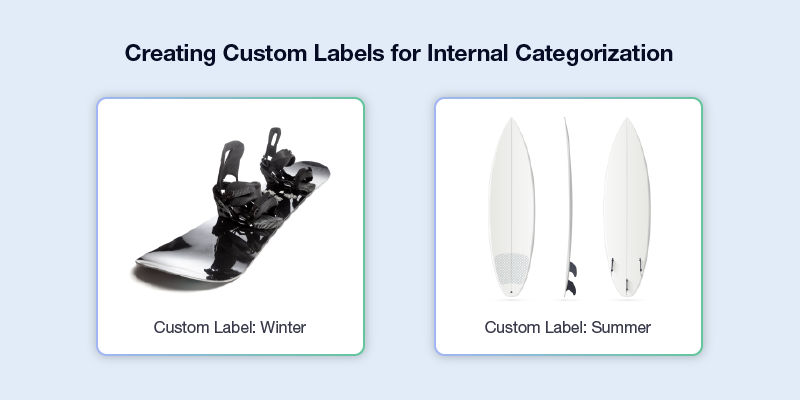
Alternatively, if you find that snow apparel sells better on some marketplaces than others, creating a “Snow Apparel” category to reserve inventory for sale on those specific channels is also beneficial.
Structured categorization enables better AI-driven product discovery
AI-driven tools like ChatGPT, Perplexity, and Google’s Shopping Graph play a growing role in product discovery. These systems often rely on structured data—such as product feeds, schema markup, or marketplace listings—to understand and recommend relevant products.
Accurate product categorization and data enrichment help AI platforms determine what your product is, where it fits, and who it’s for. For example, if you’re selling a compact air purifier and categorize it under:
Home & Garden > Household Appliances > Air Purifiers
AI systems can better recognize the context and connect it with user queries like “best air purifiers for small apartments” or “quiet air purifiers under $100.”
By contrast, a miscategorized product might get overlooked entirely, even if it’s a great match. As these AI tools continue to influence buying decisions, clear, structured categorization ensures your products are understood—not just by humans, but by the systems guiding discovery.
Correct categorization helps you avoid listing issues and policy violations
Incorrect product categorization can trigger listing issues that hurt your business. Most major marketplaces and ad platforms have strict policies around how products must be classified. If your item is placed in the wrong category, it may violate channel guidelines and result in listing suppression, reduced eligibility for promotions, or even account-level warnings.
For example, on Amazon, product categories affect everything from referral fees to compliance requirements. If you list a dietary supplement in the wrong category, your product may be flagged for violating health-related policies—even if the product itself is compliant. Similarly, on eBay, miscategorized listings may be automatically moved or removed altogether if the platform suspects you’re trying to game search rankings or fees.
Getting started with product categorization
So, you’ve decided to improve your product categorization. Great! Now, where do you start?
It is best to begin by reviewing your current product data and then sorting it into logical groups based on your organization’s procedures and sales goals. From there, review your marketplace or ad platform’s best practices for categorization. Although it is not a universal requirement to categorize your products, it is highly recommended for optimal performance on most shopping destinations.
Below are a few of the most popular channels where merchants list their products.
Product categorization on Google
On Google Shopping, categorization plays a vital role in how products are matched with relevant searches. If you don’t specify a category, Google will attempt to assign one automatically based on your product title, description, and other feed attributes—though this process isn’t always accurate and can impact performance.
To improve targeting and compliance, merchants should proactively map products using the google_product_category attribute, referencing Google’s predefined product taxonomy. Correct categorization helps improve product listing ad relevance, ensures eligibility for certain Shopping filters or promotions, and is essential for meeting category-specific requirements (like taxes or variant attributes).
Product categorization on Amazon
Amazon uses product categories to control everything from listing placement and category pages to referral fees and compliance rules. While Amazon will assign a default category if none is provided, miscategorization can lead to suppressed listings or lost visibility.
Some categories on Amazon require prior approval before you can list products within them. These are known as “gated” categories and include areas like Jewelry, Watches, and certain subcategories within Health & Personal Care. To sell in these categories, you must apply for approval through Seller Central.
Product categorization on eBay
eBay requires sellers to assign a category when creating a listing. If the platform determines that a product has been miscategorized—either accidentally or to manipulate search—it may automatically reassign it or remove the listing altogether.
Selecting the correct category is essential for ensuring your product appears in relevant browse experiences and search filters. It also impacts the availability and accuracy of item specifics, which are crucial for search visibility, buyer trust, and conversion. Proper categorization helps eBay match your product with interested buyers and power features like filterable attributes and listing recommendations.
Product categorization on TikTok Shop
TikTok Shop has seen rapid growth, especially among Gen Z consumers and DTC brands. Categorization plays a crucial role in determining how products appear in search results, hashtag filters, and in-app recommendations powered by TikTok’s algorithm.
Merchants are required to map their listings to TikTok’s predefined category structure, and failure to do so can result in lower visibility or limited discoverability within the platform’s shopping features. Proper categorization also enables TikTok to surface relevant attributes on product detail pages, which improves the overall user experience and conversion potential.
Product categorization on Meta (Facebook & Instagram Shops)
On Meta’s platforms—including Facebook and Instagram—product categorization influences how products are grouped into sets, displayed in catalogs, and featured in dynamic ad campaigns.
Meta supports a product taxonomy that aligns with Google Product Categories (GPC), allowing merchants to reuse existing mappings across multiple channels. Accurate categorization improves product relevance in dynamic ads, especially for campaigns like Advantage+ Shopping, and ensures items are included in the right product sets. Misclassified items may be excluded from these sets, reducing visibility and performance.
Product categorization on Walmart Marketplace
On Walmart Marketplace, product categorization directly affects how listings are displayed, filtered, and discovered across Walmart.com. Accurate categorization is essential for surfacing your products in the correct browse nodes, unlocking relevant product attributes, and meeting Walmart’s listing standards.
Walmart uses a defined category structure, and sellers must map each product to the appropriate category when submitting product feeds or creating listings manually. Misclassified products may be flagged, suppressed, or prevented from appearing in site navigation and search results.
Product categorization on Bing (Microsoft Advertising)
Bing, through Microsoft Advertising, supports product listing ads that appear on the Bing search engine and its extended partner network. Categorization is an essential part of product feed submission to Microsoft Merchant Center, influencing how products are displayed, filtered, and promoted.
Microsoft supports the use of the Google Product Category (GPC) taxonomy. If the google_product_category field is not explicitly provided, Microsoft will attempt to categorize products automatically using a combination of machine learning and natural language processing (NLP). This involves analyzing structured product data such as the title, description, brand, product type, and other attributes to infer the best category.
To ensure your products are categorized correctly and align with your campaigns, you should populate the GPC yourself.
Product categorization on ecommerce platforms (your own site or custom marketplace)
For ecommerce platforms like BigCommerce, Shopify, and others, proper categorization ensures consistency across your product catalog, improves internal site search and filtering, and supports SEO by structuring category and collection pages clearly.
While platform-native categories help organize the storefront and navigation, they also influence how product feeds are built and exported to marketplaces, ad platforms, and social commerce destinations if you’re not using a sophisticated feed management platform.
When running a custom marketplace or onboarding multiple third-party sellers, product categorization becomes even more critical. Inconsistent or missing category assignments from sellers can lead to disorganized catalogs, poor search/filter functionality, and a subpar user experience.
To streamline onboarding, marketplace operators should standardize their category taxonomy and enforce category mapping as part of the product submission process, either through manual review, automated validation, or integration with a feed management platform. This ensures all listings align with your site’s structure and meet the expectations of your end users.
Product categorization challenges
Each channel and marketplace has its own system of product categorization. If you’re only selling a handful of products, it’s manageable to stay on top of taxonomy changes and manually assign the most relevant categories. But what happens when you’re managing dozens—or hundreds—of product types across multiple marketplaces, ad platforms, and social commerce destinations?
That’s often the tipping point. Many merchants find themselves overwhelmed and end up settling for miscategorized or minimally categorized listings, which results in poor visibility, low conversion rates, and untapped growth potential.
While bulk upload templates from marketplaces like Amazon and eBay are intended to simplify product onboarding, they’re far from foolproof. These templates can be time-consuming to configure, category-specific fields are hard to identify and organize, and even small formatting errors can cause listing rejections or suppression.
Achieving the perfect product categorization
For growing sellers, feed management platforms offer a scalable alternative, enabling smarter categorization, reducing manual work, and improving performance across every channel.
Let the team at Feedonomics make it easy for you. Our FeedAi technology automatically categorizes your products with 97% accuracy and 17 times faster than manual categorization.
Learn how our full-service feed management solutions for advertising channels and marketplaces can help you achieve your ecommerce goals.
Product categorization FAQs
How can retailers optimize categorization across multiple channels?
Retailers can optimize ecommerce product categorization across channels by standardizing their internal taxonomy, using tools that support automation, and maintaining a consistent workflow for updating and mapping product data. This is especially important when managing a high number of products or multiple subcategories across marketplaces and ecommerce sites.
To scale across channels efficiently, many retailers turn to feed management solutions that automate taxonomy mapping and sync product data across platforms. Feedonomics’ FeedAi technology uses machine learning to accurately categorize each specific product into the right subcategory—saving time, reducing errors, and improving consistency across different categories. This level of automation helps ensure that every listing is optimized, up to date, and aligned with each channel’s categorization rules.
How does product taxonomy optimization improve conversion rates?
A well-structured product taxonomy ensures that both product pages and category pages surface the most relevant products to the right shoppers. When shoppers can quickly filter by brand, size, type, or other key attributes within clearly defined subcategories, it reduces friction and leads to faster, more confident purchasing decisions. This improves the overall shopping experience and increases the likelihood of conversion.
Optimized product classification also enables more effective on-site search and merchandising. By correctly grouping similar or related products, you can improve cross-sell opportunities, refine your targeting for marketing campaigns, and deliver better product recommendations—all of which contribute to higher conversion rates across your ecommerce site.
What should ecommerce stores consider when categorizing different types of products?
When categorizing different types of products, an ecommerce store should consider the size of its product catalog, how shoppers navigate the online store, and how products align with marketplace or channel expectations. It’s important to define a logical, scalable taxonomy that reflects both the store’s product lines and the way customers search or filter products.
Using a consistent, user-friendly taxonomy on the ecommerce website improves navigation, enhances product discoverability, and supports long-term growth. Many merchants choose to mimic existing taxonomies from platforms like Google or Amazon to ensure alignment with external channels and simplify product feed management.
How do product categories impact bidding and marketing strategy?
Product categories play a key role in shaping your marketing strategy by helping platforms group similar items together for targeting, bidding, and reporting. When products are correctly categorized, you can tailor your marketing campaigns based on demand signals, seasonal trends, and performance metrics—enabling more precise bids and better audience segmentation.
For example, an ecommerce start-up in New York selling outerwear might notice higher competition and CPCs for winter jackets. By analyzing performance by category, they can shift budget toward related products like scarves or insulated gloves, which convert at a lower price point but appeal to the same target audience. This kind of category-level insight allows marketers to stretch their ad spend while still supporting brand awareness and sales across multiple product lines.
What is a product categorization classifier?
A product categorization classifier is a machine learning model trained to automatically assign products to the correct categories based on attributes like title, description, and product type. It analyzes a dataset of labeled examples and learns patterns to predict where new products should be placed in a taxonomy. The more accurate and representative the training data, the better the classifier performs.
At Feedonomics, our FeedAi technology uses a highly tuned classifier trained on millions of real-world ecommerce listings. This allows it to categorize products with 97% accuracy—across multiple channels and verticals—saving merchants time and reducing errors, even when onboarding new or seasonally updated SKUs.

Muhammed is a content marketing specialist creating informative content to help ecommerce professionals solve industry challenges and stay ahead of the curve.
